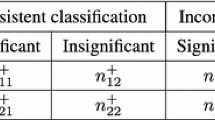Abstract
Cluster analysis is an unsupervised learning technique for partitioning objects into several clusters. Assuming that noisy objects are included, we propose a soft clustering method which assigns objects that are significantly different from noise into one of the specified number of clusters by controlling decision errors through multiple testing. The parameters of the Gaussian mixture model are estimated from the EM algorithm. Using the estimated probability density function, we formulated a multiple hypothesis testing for the clustering problem, and the positive false discovery rate (pFDR) is calculated as our decision error. The proposed procedure classifies objects into significant data or noise simultaneously according to the specified target pFDR level. When applied to real and artificial data sets, it was able to control the target pFDR reasonably well, offering a satisfactory clustering performance.





Similar content being viewed by others
References
Anderson, E. (1935). The irises of the Gaspe Peninsula. Bulletin of the American Iris Society, 59, 2–5.
Benjamini, Y., & Hochberg, Y. (1995). Controlling the false discovery rate: a practical and powerful approach to multiple testing. Journal of the Royal Statistical Society. Series B, 57, 289–300.
Bezdek, J. C. (1981). Pattern recognition with fuzzy objective function algorithms. New York: Plenum.
Bishop, C. M. (2006). Pattern recognition and machine learning. New York: Springer.
Celeux, G. & Govaert, G. (1995). Gaussian parsimonious clustering models. Pattern Recognition 28, 781–793.
Duan, L., Xu, L., Liu, Y., & Lee, J. (2009). Cluster-based outlier detection. Annals of Operations Research, 168, 151–168.
Duda, R., Hart, P., & Stork, D. (2001). Pattern classification (2nd ed.). New York: Wiley.
Dudoit, S., Shaffer, J. P., & Boldrick, J. C. (2003). Multiple hypothesis testing in microarray experiments. Statistical Science, 18(1), 71–103.
Fisher, R. A. (1936). The use of multiple measurements in taxonomic problems. Annals of Eugenics, 7, 179–188.
Fraley, C., & Raftery, A. (2002). Model-based clustering, discriminant analysis, and density estimation. Journal of the American Statistical Association, 97, 611–631.
Han, J., Kamber, M., & Tung, A. (2001). Geographic data mining and knowledge discovery. In: H. Miller & J. Han (Eds.), Spatial clustering methods in data mining: a survey (pp. 1–29). London: Taylor & Francis.
Little, M. A., McSharry, P. E., Hunter, E. J., & Ramig, L. O. (2008). Suitability of dysphonia measurements for telemonitoring of Parkinson’s disease. IEEE Transactions on Biomedical Engineering, 56, 1015–1022.
Mitchell, T. (1997). Machine learning. New York: McGraw-Hill.
Park, H.-S., Jun, C.-H., & Yoo, J.-Y. (2009). Classifying genes according to predefined patterns by controlling false discovery rate. Expert Systems with Applications, 36, 11753–11759.
Storey, J. D. (2002). A direct approach to false discovery rates. Journal of the Royal Statistical Society. Series B, 64, 479–498.
UCI (University of California–Irvine) data repository: University of California–Irvine. Center for Machine Learning and Intelligent Systems. http://archive.ics.uci.edu/ml/.
Xu, R., & Wunsch, D. II (2005). Survey of clustering algorithms. IEEE Transactions on Neural Networks, 16, 645–678.
Acknowledgements
We would like to thank the Guest Editor, Dr. Victoria Chen, and anonymous reviewers for their helpful comments. This research was supported with Basic Science Research Program through the National Research Foundation of Korea from the Ministry of Education, Science and Technology (Project No. 2011-0012879).
Author information
Authors and Affiliations
Corresponding author
Appendix: Validity of the method for calculating p-value
Appendix: Validity of the method for calculating p-value
In order to check the validity of the proposed method for calculating p-value explained in Sect. 2.2, we will consider the univariate normal case. Let us assume that each object follows a standard normal distribution. Then, the true p-value is obtained by (20).
where cdf is the cumulative distribution function of the standard normal distribution.
To compare the performance, 1000 observations were randomly generated from the standard normal distribution. Table 18 shows a partial result of the proposed method as compared with the true p-value. The mean absolute error (MAE) between the true p-values and the estimated p-values for 1000 values is 0.0032, which seems to be acceptably small.
Although the results are not shown here, the proposed method for calculating p-value was also tested for other distributions such as F distribution and chi-square distribution, showing good performance.
Rights and permissions
About this article
Cite this article
Park, HS., Lee, J. & Jun, CH. Clustering noise-included data by controlling decision errors. Ann Oper Res 216, 129–144 (2014). https://doi.org/10.1007/s10479-012-1238-7
Published:
Issue Date:
DOI: https://doi.org/10.1007/s10479-012-1238-7




